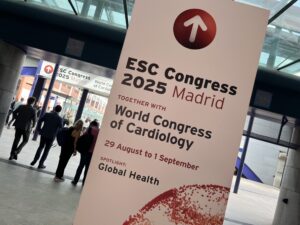 Beta-blocker therapy appeared to be ineffective at reducing death, reinfarction or hospitalisation for heart failure among patients discharged after invasive care for a myocardial infarction (MI) who had a left ventricular ejection fraction (LVEF) above 40%, results of the REBOOT trial presented at the European Society of Cardiology (ESC) 2025 congress (29 August–1 September, Madrid, Spain) and published in the New England Journal of Medicine have shown.
Beta-blocker therapy appeared to be ineffective at reducing death, reinfarction or hospitalisation for heart failure among patients discharged after invasive care for a myocardial infarction (MI) who had a left ventricular ejection fraction (LVEF) above 40%, results of the REBOOT trial presented at the European Society of Cardiology (ESC) 2025 congress (29 August–1 September, Madrid, Spain) and published in the New England Journal of Medicine have shown.
The results of the trial run counter to decades of practice, the study’s investigators have said, with evidence supporting the practice of beta-blocker therapy in this patient population having largely been gathered prior to the time of routine reperfusion, invasive management, potent antiplatelet therapies and statins. The findings, they state, justify a re-examination of the role of beta-blockers, particularly among patients with uncomplicated MI and LVEF >40% in whom the benefits of beta-blockers are not well established—unlike with reduced LVEF (≤40%).
“REBOOT will change clinical practice worldwide,” says Borja Ibáñez (Centro Nacional de Investigaciones Cardiovasculares, Madrid, Spain) who presented the results at ESC 2025 and served as the trial’s principal investigator. “Currently, more than 80% of patients with uncomplicated myocardial infarction are discharged on beta blockers. The REBOOT findings represent one of the most significant advances in heart attack treatment in decades.”
The investigator-initiated randomised open blinded-endpoint REBOOT trial was conducted at 109 centres across Spain and Italy. Patients with MI (with or without ST-segment elevation) were eligible for enrolment if they underwent invasive management during the index hospitalisation and had a predischarge LVEF >40%, with no history or signs of heart failure. Patients were randomised 1:1 to beta-blocker or no beta-blocker therapy. The primary endpoint was a composite of all-cause mortality, nonfatal reinfarction or heart failure admission.
Among 8,505 patients who underwent randomisation, the mean age was 61 years and 19.3% were women. A total of 10% had a prior MI and 12% were on beta-blocker treatment before the index hospitalisation.
After a median follow-up of 3.7 years, the primary composite outcome of all-cause death, nonfatal reinfarction or heart failure admission occurred in a similar proportion of patients in each group: 22.5/1,000 patient-years in beta-blocker group and 21.7/1,000 patient-years in the no beta-blocker group.
All-cause mortality occurred in 11.2 and 10.5/1,000 patient-years on beta-blocker therapy and no-beta blocker therapy, respectively. Non-fatal reinfarction occurred in 10.2 and 10.1/1,000 patient-years, respectively, while heart failure admission occurred in 2.7 and 3.0/1,000 patient-years, respectively.
Regarding safety, admission for stroke occurred in 2.6/1,000 patient-years in the beta-blocker group and 1.7/1,000 patient-years in the no beta-blocker group. Admission for symptomatic advanced atrioventricular block occurred in 0.5 of patients in the beta-blocker group and 0.4/1,000 patient-years of patients in the no beta-blocker group.
There appeared to be an absence of benefit with beta-blockers across the prespecified subgroups. However, fewer events were noted in patients with mildly reduced LVEF (40−49%) on beta-blockers vs. no beta-blockers, although low patient numbers limit interpretability.
A subgroup analysis found that women treated with beta blockers experienced more adverse events. Results showed women treated with beta-blockers had a 2.7% higher absolute risk of mortality compared to those not treated with beta-blockers during the 3.7 years of follow-up of the study. The elevated risk when treated with beta-blockers was restricted to women with a complete normal cardiac function after a heart attack (LVEF of 50% or higher). Those with a mild deterioration in cardiac function did not have an excess risk of adverse outcomes when treated with beta-blockers.











